
Decision-making methods help groups make decisions. There are different decision-making methods – but none of them fell from the sky. Think for example, about parliamentary procedures. They are human-made, abstract concepts! Any decision-making method is imperfect, and each of them comes with implications, pros, and cons. The good news is that we have a choice of what decision-making methods we want to use.
When we make that choice, we have to factor in that any decision-making method affects group dynamics. Imagine a group decision where one group – let’s call them the orange group – is clearly in the majority. The orange group wants proposal A. Yet, the purple group has good reasons for proposal B. Now, what is going to happen?
In a culture where majority vote is used to make decisions, the orange group doesn’t even have to consider the input from the purple group. They already know they won’t have to listen and will get “their” way anyway. This is just one example of the dynamics that play into decisions but also the way we enter the discussion in the first place. In one sentence, “Behavior is determined by the prevailing method of decision making” (Gerard Endenburg) – the decision-making method we use will bias us.
What are the major decision-making methods?
There are basically five decision-making methods that exist in our typical Western culture:
We’ll go through them one by one, exploring what kind of behavior they reward.
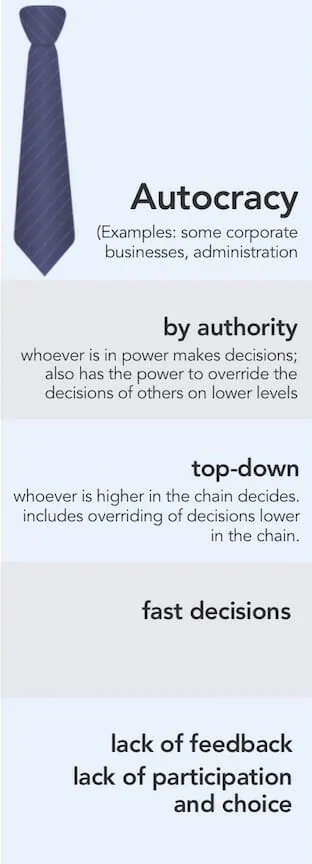
Autocratic decision-making
If one person can decide, just because one person has the power, we have autocratic decisions. It might be the boss, the dictator, the teacher, the parent, or an autocratic founder of a business. For whatever reason, we find ourselves in a system where most have no power, and one person has most of the power. Typically, these are situations where we heavily depend on the person in control, and we have no way of changing the power structure.
How will that kind of situation affect our behavior? Since we have no way of changing the power balance, we might feel disengaged and resentful. At the same time, we don’t want to lose our job, our teacher’s goodwill, or the founder’s support. So, in a scenario, what will the people without power do? Besides disenfranchised workers, we can find ways of sneaky disobedience — bending the rules, and sabotage. We can withhold information, taint information, and cut out people who might endanger our position. We can try to get into a more favored standing with the holder of power. We will either solidarize with the oppressed, or side with the powerful. Or we can just keep a low profile.
If we are that person of power, we might be aware of people who disagree. So we might be scared that there will be a rebellion. To prevent that, we will withhold information, and bend facts. We will try to get into a more favored position with the next-higher holder of power. Or we might be resentful of all the people who push responsibility on us, the decider.
Note that both sides are behaving and feeling quite similarly! Why? Because the game is the same.
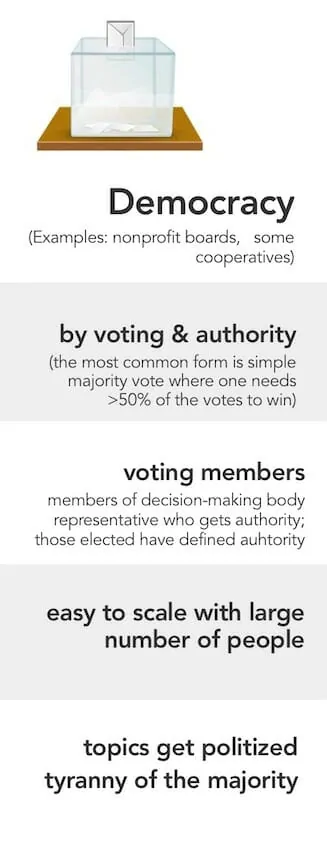
Majority vote decision-making
The second decision-making method is majority vote. Historically, majority vote liberated us from autocratic leaders. However, it is striking how similar the situation is to autocratic conditions. The pattern, again, is very similar. You either vote for one side, or against it. There is nothing in between because, in the end, you have to check off one or the other. You can’t write a commentary onto the ballot.
There are not many nuances in voting.
Therefore, the behavior rewarded by majority vote does not allow for nuances. It’s not about finding good solutions in the middle or anywhere, it’s about winning votes. The rules of the game are about polarizing views, taking a stand, and having a clear position. Even if, in reality, people hold more nuanced opinions, they have to polarize to brand themselves into a position that is distinguishable from the other candidate. It’s not their fault. It’s simply the behavior that the rules of the game will reward.
It is unlikely that a two-party system (and even a system with more parties) will represent all of our views. We have to let go of some views or get in line to avoid cognitive dissonance. Given how it polarizes and cuts out nuances, it’s hard to believe that majority vote is held up as the gold standard of decision-making methods! Again, it’s better than kings and queens… but it’s still not good.
Tyranny of the majority
And even after the election, the game continues.
There is no need to consider the minority because concessions to the minority put us at risk of losing votes for re-election. What was a majority once needs to remain a majority. Therefore, we have to oppress the other side to keep winning. Since there’s only winning and losing, we don’t really have a choice.
Note that the basic pattern is true for either side of the political spectrum. It is the system that rewards this kind of behavior — sometimes more, sometimes less. If political leaders see value in honoring all of their constituents’ needs, they might play nice. In the grand scheme of things, political parties and the candidates themselves are just players in a system that holds them captive just like anyone else. As children, we grow up thinking the president can decide anything. As we grow up, we see just how little can even be decided in our current systems.
Preferential vote can be a way out of this as it softens the effects of majority vote. It is most suitable for candidates, however, not for policy questions, so the problem of yes/no questions on the ballot often remains.
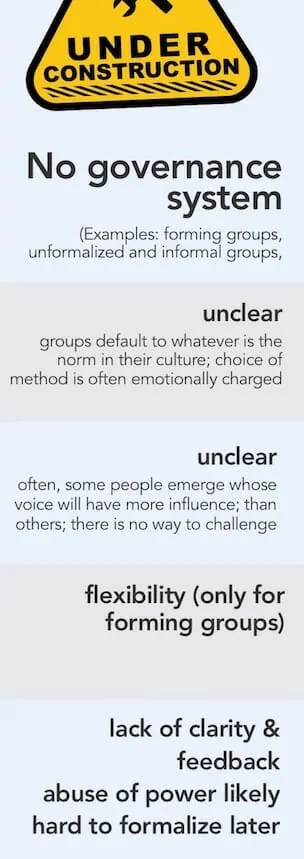
Unclear decision-making
Unclear decision-making is not a decision-making method. Yet, I am listing it here because it’s a reality in many organizations. My experience is that most friend groups, families, and peer-oriented teams make their decisions with this vague decision-making method.
This is a mix of decision-making methods. People might be assuming a consensus-like structure but they don’t really follow through. That often looks like this: lots of talking with no solution. As people lose their patience, one group starts to stand its ground. People who don’t agree with the position need to be persuaded. No one really asks for a final yes or no. The decision is just somehow made. Or at least some people assume it has been made and start carrying out the decision.
Tyranny of structurelessness
It follows the majority, or the louder faction, or the most powerful person in the room. Although we might want everyone to agree, we don’t really give people a chance to disagree.
The tricky thing about this kind of ‘non’-decision is that it’s hard to address and therefore also hard to challenge or change. Those who use the void to get what they want can tell themselves they’re the good guys – after all, the other people didn’t say no! So they agreed, right? Those who are taken advantage of have a hard time putting their finger on the problem because the decision-making method is unacknowledged. In addition, those who benefit are often those who are used to speaking assertively, from a privileged position. It’s a messy game. The term “tyranny of structurelessness” describes this well.
Most of the time, people just shrug and move on. They leave if they can. In the long run, this is not healthy. On top of that, decisions “made” this way are also chronically unclear which makes it hard to act on them.
Once an organization is used to this kind of vagueness, it is almost impossible to formalize it – especially because no system is in place to make the decision of how one makes decisions in the future. (See my book Who Decides Who Decides on the topic.)
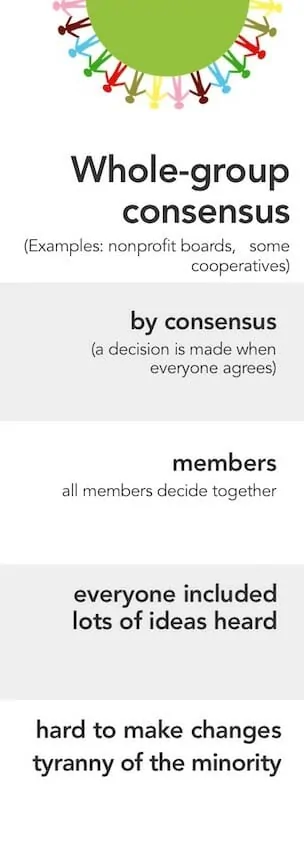
Consensus decision-making
Formal consensus is common in some pockets of our culture: young start-ups, cooperatives, and communities. If it’s implemented as an explicit decision-making method, it is acknowledged and can be addressed. There is a less formal version of consensus, for example, in couple relationships.
The good thing about consensus is that it’s inclusive. No one can be forced to do anything. In terms of behavior, divisive behavior will not get anyone to a result faster so there might be less polarization. So people might actually listen to each other and try to find a solution that works for everyone.
Do people get their first choice, or not?
Yet, there’s one tricky dynamic, and it has to do with the difference in preferences and what we’re willing to do. Let’s look at an example.
Let’s say one partner in a couple wants to go to the movies. She might say, “hey do you want to go to the movies?” The problem with this kind of question is that we often interpret it as questions about our preference. We’re being asked what we want. So in a situation where the partner would have been ok with movies but would rather go out to eat, he might say, “no, let’s go out to that new restaurant instead”. Hearing a no is not easy for most people, and not getting what we want is not easy either. In a less-than-ideal world, the two partners might argue over the best way to spend the evening. Although there was a solution (= going to the movies) that would have worked well for both of them! They were simply talking about their preferences and weren’t explicit about the fact that there’s more they could do except that personal #1 choice.
So what are our options in consensus if our preferences don’t match?
- I can try to convince you that my view is right. This can quickly turn into ideological arguments similar to majority vote, especially in split decisions.
- I can push for you to “stand aside”, i.e., for your voice to be ignored for the sake of the group that wants to move forward.
The tyranny of the minority
For group dynamics, convincing other people and standing aside can be toxic. People don’t typically cave in without resentment. While we might hear more about the other people’s motives — much more than in majority vote — the energy can easily tip into convincing each other rather than listening. Therefore, consensus works well in homogenous groups valuing community and with excellent communication skills. It’s harder when there is less overlap and fewer skills.
Another significant factor is the fact that any proposal can be shot down. “I proposed a plan and I was willing to do all the work. But some people didn’t like it. So the project didn’t move ahead.” Those kinds of dynamics give rise to chronic disappointment and frustration as groups might find themselves in endless discussions, over and over again, and do-ers roll their eyes and start to give up.

Consensus promises to balance the power between individuals and groups. But sometimes it gives individuals who block a decision more power than seems appropriate. To reflect that, people sometimes call this the “tyranny of the minority.”
Consent decision-making
The final decision-making method here is consent. Consent is a version of consensus. (If consensus means that not everyone gets their first choice, consensus and consent are basically the same.)
Consent turns the question around: instead of asking for what we want, we ask whether there are reasons not to go ahead. Those reasons would take the form of an objection.
Consent can be a formal process, or groups can use it informally. For example, I have made good experiences by asking my kids, informally, “is there any reason for any of you not to do this?” Instead of asking “is that what you want?”
See the diagram below. Between our preference and our objections, there is another area: the range of tolerance. It’s maybe not what we wanted, but there’s also no reason to say no, so we can give consent and move on as a group. Working with that range of tolerance gives us a lot more options to work with. That way, it will be easier to make a decision.
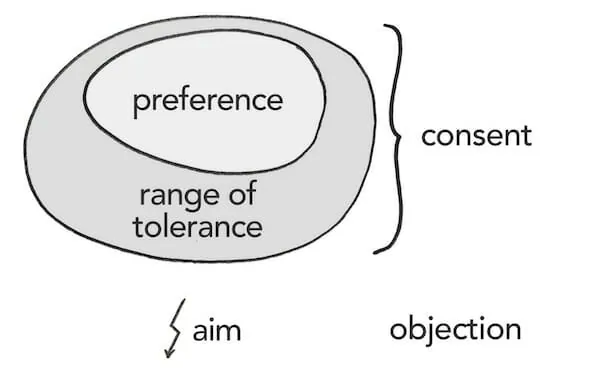
In the case of an objection, we hear and try to understand how our proposal negatively affects the other people in the group, and we try to find ways to address the objection. (See this article on integrating objections.) Sometimes, a group might decide to resolve an objection by shortening the term of the proposal — “let’s try it for 3 months and see what happens,” instead of aiming for a decision that will be in effect “forever”. That takes some pressure off the right/wrong thinking and can help ground the group in data instead of ideology or fear.
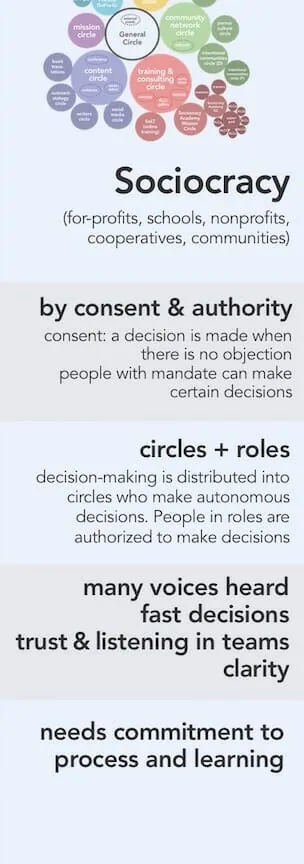
Positive effects of consent
On the plus side, consent has quite a few positive effects on our behavior:
- There are no sides anymore, no right/wrong, and no “are you with us or against us“. There is just a group trying to find just enough common ground to move one step forward.
- We don’t have to convince each other as the goal is not to be right, just to find out whether there are objections. That leaves more room for listening as we’re not in the defensive.
- Consent is inclusive. There is room for different views and preferences. Together, we focus on the next-viable step forward that allows everyone to be on board. As such, consent invites both-and thinking, holding different opinions while accepting that there is no absolute right or wrong.
- Consent rewards self-responsibility because no one can step aside, be ignored. Also, power games are not viable. In the end, everyone will be asked for consent.
- In small groups, one can use consent to elect people into office. As a result, the behavior of leaders changes because divisive or dismissive behavior does not bring advantages anymore.
Limitations of consent
Just like all decision-making methods, consent has its limitations. One is that consent is not easy to do on a large scale, unless groups fall into ‘layered’ sets of groups, each operating by consent (as sociocracy practices it with a fractal structure of nested circles).
The other limitation is that consent rewards rational and compelling arguments. This might not be a problem everywhere. But it can create a barrier for people who have a hard time following formats or get anxious in structured approaches. In addition, it also requires a context where objections are culturally possible — age, gender, privileges related to race and class, and introversion might affect how likely someone is to speak up and propose something or object. This can be demanding for people who are not used to being in power. It can also require patience from people who are used to making quick, unilateral decisions.
Lastly, the maybe most significant issue is that it requires integrity and self-responsibility to object. Also, integrating objections requires skill. Consequently, it will depend on how experienced and resourceful groups and facilitators are whether consent is filled with life
Conclusion
Admittedly, I have a clear bias towards consent. But I am aware of how much training and practice it will take to make consent as a default decision-making method viable for many.
Most likely, there are no perfect decision-making methods. Each method of decision-making comes with its own challenges and benefits. From a position of systems thinking, it is crucial to see how the decision-making method affects behavior. Awareness around patterns in decision-making and group processes, in general, can help us use those patterns wisely and design the systems that support us in being how we want to be.
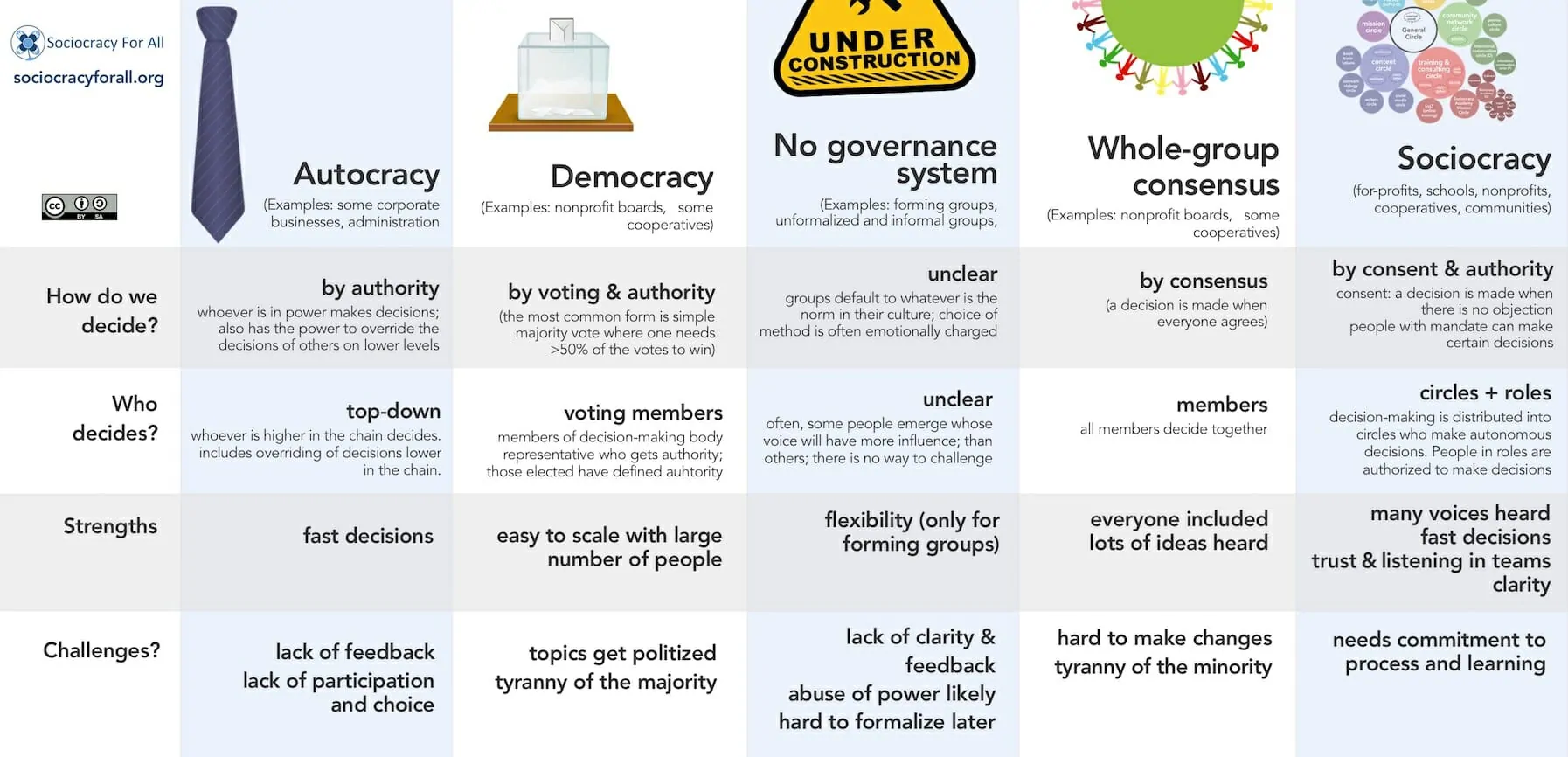
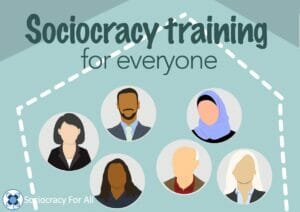


Leave a Reply
You must be logged in to post a comment.